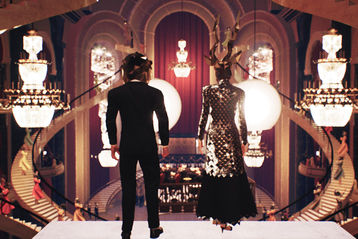As part of an impressive repertoire for their month-long 20th anniversary edition, the Belgrade Dance Festival presented his remarkable, and often disturbing piece, Elenit. We sat down with him two days before the performance in the centre of Belgrade, during a press conference organised by the Belgrade Dance Festival.
Could you tell us a bit about your process? Where do you get all these crazy ideas from?
In my work, creation begins the moment I envision a creature or a character that I will impersonate myself. From that point on, this creature starts to haunt me until I put it on stage. This process usually takes two years. The moment I premièred Titans in 2017, I went to see this show with friends. And while I was watching the show, I suddenly had an image of a short creature with curly hair, very nervous, surrounded by a circle of lights, and playing a guitar. I thought this was going to be funny, and I immediately realised that this would be a new piece. Later down the line, I realised that in that piece behind me was a shadow of a corpse dancing around in a cave, on my right-hand side I had a dinosaur and on my left-hand side I had a normal man. Of course, I don't know what these things are, but if they come to me, I have to find a way to put them on stage. They are very subconscious.
The universe that we create on stage is not linear. There is no story. It is an open form for people to decipher through their own experiences and their own personal necessity. There is no right or wrong. Hopefully, it is a show that triggers the audience’s senses and enhances their imagination to create their own story depending on their own personal mythology and knowledge.
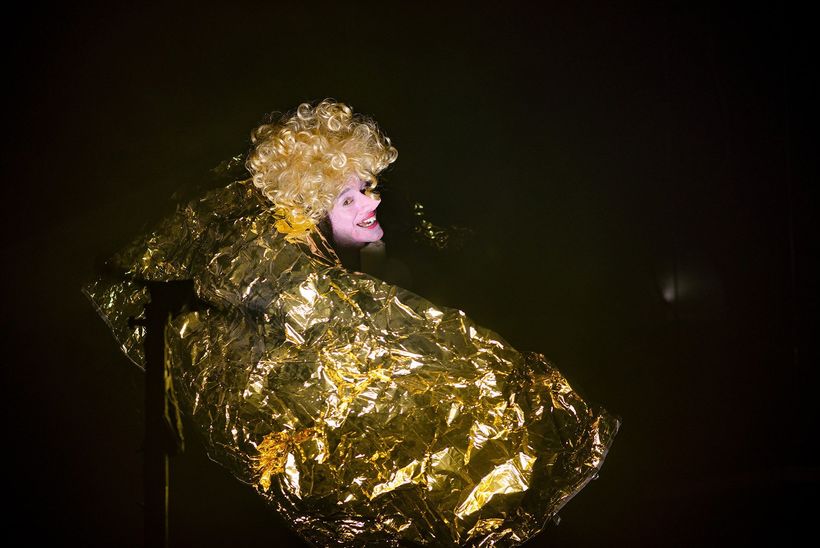
You say you start with an initial vision of a character or scene. Is the content fixed from the moment when you get this initial vision, or does it develop?
It develops a lot. In the beginning, there is nothing that I want to say or convey. I have a broad feeling of what it’s about. I know the people, the sound. For Elenit, I could not put into words exactly what the sound was going to be, but I have collaborators with whom I communicate on this level and they are very comfortable going into the creative process with only this information. Also, I think the more I grow, I understand that even though my background is theatre – and I was a theatre actor and director for a long time – my universe does not contain language or even actual words. I now understand this is not a coincidence. There is a space containing things that we cannot talk about, which I find very interesting. Words are sometimes a poor communicator, with limited meanings. So, it's a blessing that dance festivals include my work, because it's very quirky and weird, but dance as an art form is very open and it has the ability to include strange voices like mine. Dance is embodied. You don't need words. And that's where I'm comfortable. I don't like to categorise, I don't like to limit meaning. I like the implicit rather than the explicit.
When I was a kid at school, my teachers would show us a poem by Kavafis, or whoever, and ask: “What is the poet trying to say?” But how can I ever know what the poet is trying to say? Usually, the poet doesn't know what he is trying to say. It's not about getting it right. A poem is meant to escape one single meaning. So, to answer your question, the content comes later and remains open.
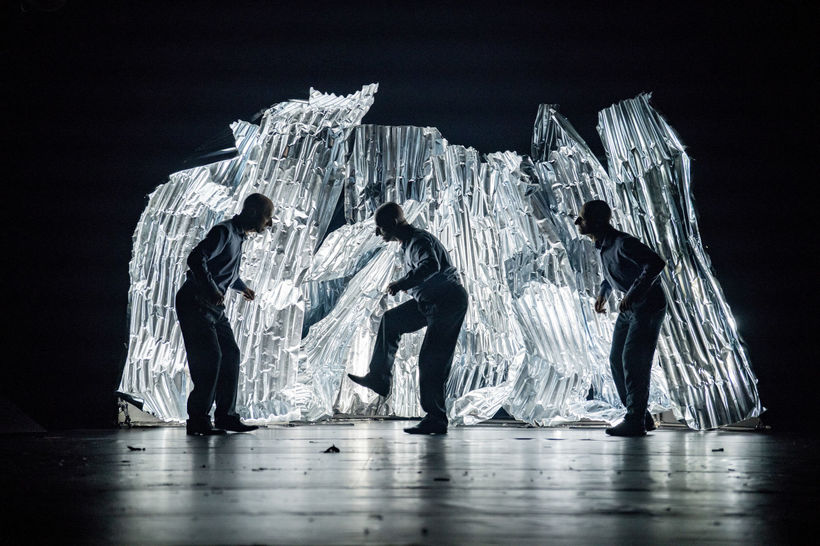
Let’s talk about the title of the piece, Elenit. What meaning do you give to it? Why did you choose this name?
It’s a title that came to me as soon as I realised that within the universe of this new piece, there was a specific material I know very, very well. It is those corrugated metal sheets that you see used in construction everywhere. You'll see them here, or in Hong Kong, New Zealand, or Canada, they’re everywhere. In Greece when I was a kid, we used to go to the construction sites where my father, who was an architect, worked. And there was this one particular material that I would see in Athens in the buildings, but also, on the island where I come from. I would always ask about it. In my childish imagination there was something very strange about it, because I didn't see much in common between the island in the summer, and the city in the winter. My father kept on saying, “oh, this is elenit”. But that was a lie because when I grew older and I said, “I'm going to make a show with elenit”, he said, “you can't do that”. “Why?”, I asked, “the material is nice”. He said, “No, no, it's carcinogenic. The metallic thing you want, it’s called a ‘corrugated metal sheet’”. Elenit is a different thing, and it’s no longer there because we cannot use it. The thing that used to be corrugated metal was carcinogenic and it was removed and, because it was so cheap and durable, they replaced it with the metallic corrugated sheets that you see in everybody’s buildings.
In every language, there is a different version of elenit. I'm sure you have another word for it here. The thing is, in Greece we call it elenit because it sounds like Hellas, the Greek word for Greece. Of course, it killed people because it was toxic and it was removed. So not only did the material not live forever, but people no longer lived under it either. When I realised that this was a huge misunderstanding, I thought it would make a perfect title for this piece. Because again, the words did not reflect reality.
So elenit is carcinogenic. Is the piece also dangerous?
I think the biggest challenge for the audience with this piece is to enjoy it without trying to understand it. I think that's the most dangerous aspect, if you come in trying to understand what is going on and to nail it and leave thinking, “sure, I get it, I know what it means, I know what happens”, I think that's going to be the biggest danger.
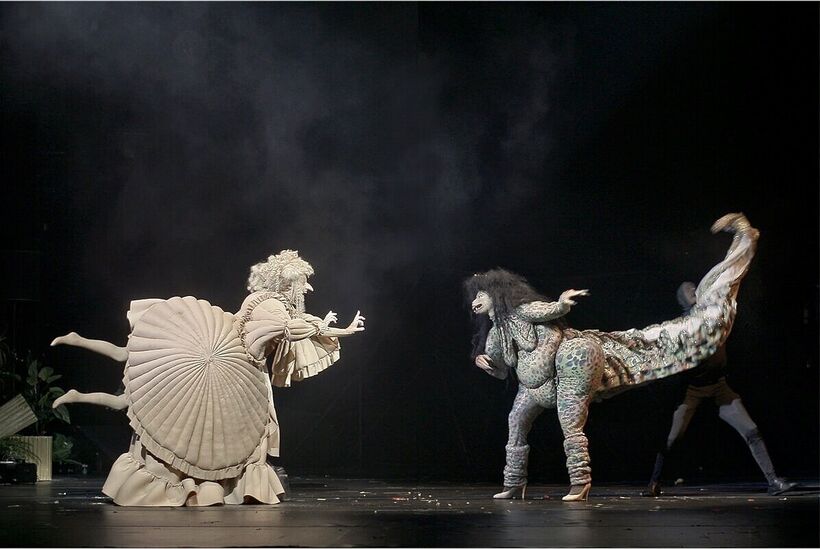
It seems that sounds and music are important in this piece?
Music plays an integral part in my work precisely because I don't have words for it. When language comes, it’s music, it’s intonation. For me, the lights, the music, the performers, the set, everything starts together from the beginning. A lot of times in this business, you create the show and the last two weeks before it’s performed, some costumes materialise, a little bit of lighting, and then we have the show. For us, we work for three to four months with the sound as if it's the last day of rehearsal. We have mics, we have the sound person with us, and the composer is with us every day. So, it's very integral. The voice, the body, the lights, the sound, the set, and the props are just as important as the performer.
And about your performers, what are you looking for when working with them?
I love performers that have a good sense of form, usually dancers. They should be hard workers because we do things again and again and again and again. It's never-ending. I work with actors as well because some of them are really hard workers and they get it. But mostly I think of dancers. I was trained as an actor and I know that actors want an answer. They're asking why: “Why do I go there? Why do I lift my hand?” And sometimes my direction is to lift your hand, a little bit higher, a little bit higher, there. And an actor would ask why. The dancer doesn't care. The dancer is like here, here, here. What do you want? Okay, here. They don’t need to know the back story. It's a training exercise, you first present the form and then you figure it out, which I think is a different approach compared to classical theatre where you first have to find the feeling. This has always been problematic for me, even when I was a student and an actor. Everybody told me to never work with a mirror because you become narcissistic and forget about the emotion inside. But for me, if I don't work with a mirror, if I don't see the form, I don't understand what I'm doing. I think it’s the form that contains the meaning, rather than the feeling. The feeling is not necessary. It’s more important to be full of imagination. That is much more interesting.
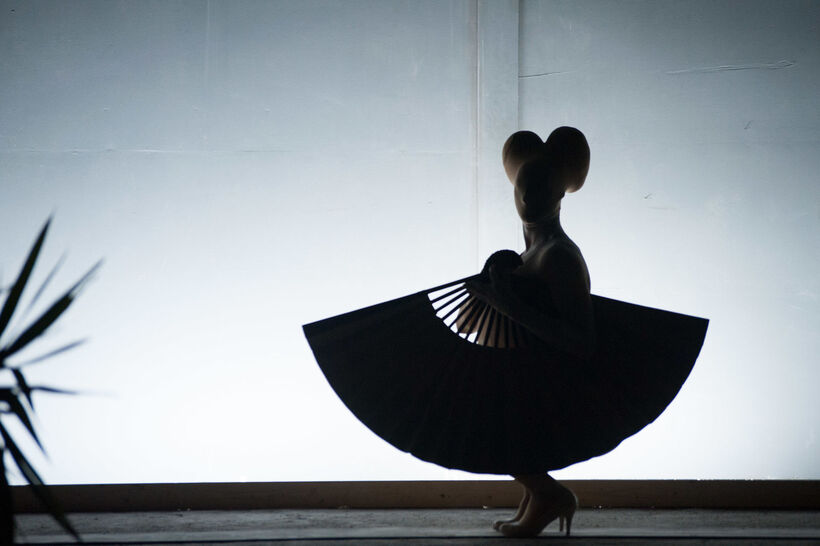
Could you tell us about your early influence and inspiration?
There are several people that have inspired me. In the 6th grade at school, I had my first encounter with theatre. There was a very blessed woman, Maria Katzouraki-Chrysomalli, that taught us theatre in school. She came from a specific theatre tradition because her husband was an actor and she was an art lover. She came with a style that was very close to what I'm doing right now, something I realised much later. We would create the shows together. She would inspire us like crazy. We were in love with her. We would perform in a theatre that used to be a gymnasium. We made the props together, we put on makeup together, we went shopping together, and we created everything by hand.
And of course, there is Dimitris Papaioannou. I started to see Dimitris’ work when I was in drama school and I clearly remember going to one of Dimitris’ shows. A friend of mine just took me and said: “I'm going to take you somewhere you’ll like”. I saw a piece called A moment’s silence, with stairs and people falling down the stairs. I was probably 20 and my jaw just dropped to the floor. I had no idea. I said to everyone that they had to go see this show, it was so amazing. One of my favourite teachers at the time was teaching art history. When I told her about the show, she said “Oh, yes, we heard about him. What he does is not really dance, is it?” But I thought, why do we care about that? You know, it was interesting back then, it was an issue. Is it dance? Is it not dance? What is it? Thank God it's not an issue anymore. When I started to work with Dimitris, I saw the way he works with images, with material, with props, with music, with sounds, and it was a huge influence on the way I think of my work.
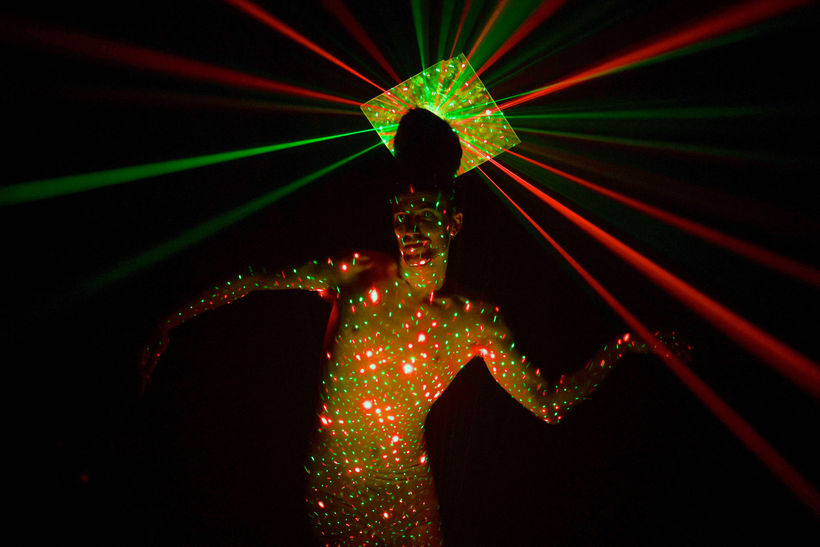
Some may characterise your work as grotesque. There are also a lot of extremes, a kind of ridiculousness in it. How do you combine the two?
Grotesque and ridiculous don't necessarily go together. I don't always recognise grotesqueness in my work, even though I understand why people think that. But ridiculous, yes, I aim for it and I love it. I think humour and ridiculousness are good ways of talking about things that hurt, without them hurting too much. My favourite playwright is Ionesco, who describes the feeling of watching oneself and one’s society from afar. Once you detach yourself, you can see from afar how you cry or how you get mad. Then, you can just laugh about yourself because you know it's all fleeting. In a couple of years, or twenty, fifty or seventy years, we will be in the ground. So why the big fuss? I think it’s quite funny how, in essence, we are so fragile, and we still take ourselves so seriously. We are so small in the context of the universe. It's a very good door to open, to talk about things that hurt because of course, you can’t not be sad if your mother dies, you know? For you, it’s important. So how do you talk about it without taking yourself too seriously? That’s my big question.
Press conference organised on 27th March, at the National Foundation for Dance, Belgrade.
Euripides Laskaridis
A graduate of the Karolos Koun Art Theatre school in Athens, and a MFA from Brooklyn College in New York on a Onassis Foundation Scholarship, Euripides Laskaridis has ample experience both as a performer, theatre, and movie director. In 2009, he founded the Osmosis Theatre Company, with which he delivered site-specific performances, workshops, and community work throughout many cities and festivals in Greece. Before that, he collaborated with several renowned artists such as Dimitris Papaioannou and Robert Wilson.
In 2015, his first piece, Relic, was selected for the Aerowaves festival in Barcelona. This was only the beginning of his long travels across Europe and beyond, visiting up to 30 international festivals and venues, such as the Public Theatre in New York, and the Israel Theatre Festival. He then took his next piece, Titans, to the FTA Festival TransAmériques and the Hong Kong Arts Festival. Relic was nominated for two UK Theatre & Technology awards and won the ‘Creative Innovation in Lighting’ category. Titans was created in 2017 as an international co-production and it is still touring, along with Relic and Elenit. In addition to his theatre and dance productions, his first short film won the Cinedans award in Amsterdam and the 2007 Jumping Frames Award in Hong Kong, and his second film was selected for the 14th Thessaloniki International Documentary Festival in 2012.









